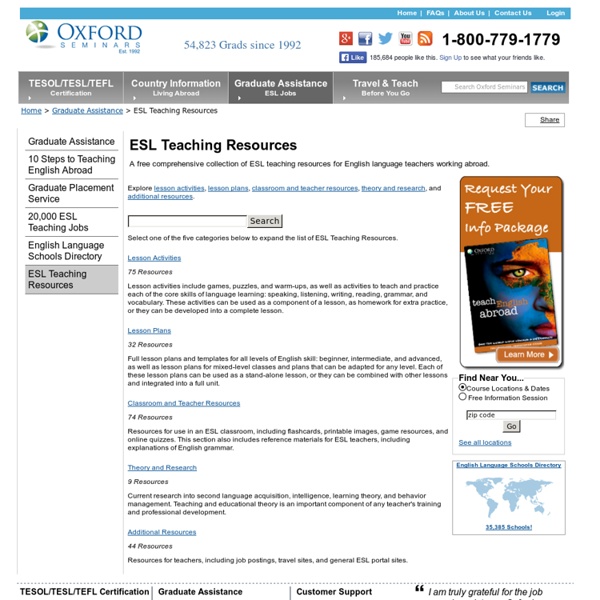ESL Teaching Resources for English Language Teachers

Learnclick Blog | Make it click! Create a Quiz.
Guest post by Marina Petrovic, Online English and Serbian teacher I’ve been teaching languages online since 2008. You may imagine that I have tried out a myriad of different tools since my first online lesson! For synchronous teaching: Skype/FB After working with various virtual classrooms for years, starting with ancient DimDim and then pricey AdobeConnect and popular WizIQ, I ended up using Vyew. For synchronous and asynchronous teaching: Google documents Of course, Skype along with Google doc! For asynchronous teaching: Blogger and Facebook page for sharing content Blogger is the simplest form of blog I would advise teachers to use. I hope you enjoyed learning how I perfected my online teaching in years while downsizing the number of tools and platforms. I would like to invite you to share your online teaching experiences, your blogs and your favourite tools! You can now import questions into Learnclick or export Learnclick quizzes. Username: demo Password: demo Examples:
4Teachers : Main Page
Humanities | ELT Journal | Editor's Choice: free to access articles
We use cookies to enhance your experience on our website. By clicking 'continue' or by continuing to use our website, you are agreeing to our use of cookies. You can change your cookie settings at any time. <p>We use cookies to enhance your experience on our website. By continuing to use our website, you are agreeing to our use of cookies. You can change your cookie settings at any time. Skip Navigation Oxford Journals ELT Journal Editor's Choice: free to access articles The editor has selected one article from each of the latest issues of the ELT Journal to be available online for FREE. Transforming professional learning into practiceVolume 70 Issue 3 July 2016 Iclal Sahin and Ali Yildirim Language teacher associations: key themes and future directionsVolume 70 Issue 2 April 2016 Amos Paran Language teacher action research: achieving sustainabilityVolume 70 Issue 1 January 2016 Emily Edwards and Anne Burns *NEW* Watch the related author video here The Journal Editor Graham Hall Reviews Editor
16 Websites to Teach and Learn Vocabulary
There are now several web tools that are really great in teaching vocabulary and that you can use with your students in the classroom. We have curated a list a list of some of the best web tools to teach vocabulary. Check them down below. 1- Vocabulary.com This is a website that will hep students master the vocabulary essential to their academic success. 2- BBC Learning English In this section, learns will have access to a plethora of vocabulary act ivies and tasks great for classroom inclusion. 3- Confusing Words Confusing Words is a collection of 3210 words that are troublesome to readers and writers. 4- Just The Word Just The Word is a cool website that helps students make informed decisions as to the right word selection to use in their writing 5-Lexipedia Lexipedia is an online visual semantic network with dictionary and thesaurus reference functionality 6- Wordnik Wordnik shows definitions from multiple sources, so you can see as many different takes on a word's meaning as possible.
Supporting English Language Learners (Tools, Strategies and Resources)
This site is intended for use by teachers, administrators and consultants working with English language learners. This site allows users to: Search the Alberta K-12 ESL Proficiency Benchmarks.
English news and easy articles for students of English
Elementary Test Prep Center- ELA 4 Test
About the Exam: The New York State English Language Arts (ELA) test is administered to fourth graders in late January or early February. New York State has set higher learning standards for all students. To reach these standards, the ELA test challenges students to demonstrate their ability to listen attentively, read a variety of materials, and respond in writing to literary and informational passages. The test is administered over three days and includes: Session 1: 5 reading passages, 28 multiple-choice questions, 45 minutes Session 2: Part 1: Listen to a passage – 2 short responses, 1 long response (basic essay format). 30 minutes. Part 2: Write a composition, 30 minutes Session 3: Read 2 related passages – 3 short responses, 1 long response, 60 minutes The multiple-choice questions will be scored using an answer key. Purpose of this Site: This site is designed to provide useful information about the NYS English Language Arts Test for teachers, parents and students.
English Prepositions
So what are prepositions? A preposition is a word which is used before a noun to show its connection to another word in the sentence. For example: The dog rests on the armchair. (The word "on" is used before "the armchair". We understand that the dog is on the armchair. The name "preposition" (pre + position) means "put before". Here are some more examples: She stands by the tree. The cat leans against the garbage can. The sign is under the car. The rocket went through the heart. They flew into the snow. She is reading to her babies. He is climbing up that mountain. A preposition can come before a pronoun as well. For example:
Web of Notes | Junior and Senior Cycle English for Teachers and Students
Related:



